Details

Further Adventures of the Celestial Sleuth
Using Astronomy to Solve More Mysteries in Art, History, and LiteratureSpringer Praxis Books
|
53,49 € |
|
| Verlag: | Springer |
| Format: | |
| Veröffentl.: | 31.01.2018 |
| ISBN/EAN: | 9783319703206 |
| Sprache: | englisch |
Dieses eBook enthält ein Wasserzeichen.
Beschreibungen
<p>From the author of "Celestial Sleuth" (2014), yet more mysteries in art, history, and literature are solved by calculating phases of the Moon, determining the positions of the planets and stars, and identifying celestial objects in paintings. In addition to helping to crack difficult cases, these studies spark our imagination and provide a better understanding of the skies. Weather archives, vintage maps, tides, historical letters and diaries, military records and the assistance of experts in related fields help with this work.</p><p>For each historical event influenced by astronomy, there is a different kind of mystery to be solved. How did the changing tides affect an army's battle plans? How did the phases of the moon affect how an artist painted a landscape? Follow these exciting investigations with a master “celestial sleuth” as he tracks down the truth and helps unravel mysteries as far back as the Middle Ages and as recent as the iconic 1945 photograph of a kiss inTimes Square on VJ Day. Topics or "cases" pursued were chosen for their wide public recognition and intrigue and involve artists such as Vincent van Gogh and Claude Monet; historical events such as the campaigns of Braveheart in Scotland and battles in World War II and the Korean War; and literary authors such as Chaucer, Cervantes, Shakespeare, Byron, and Edgar Allan Poe.</p>
<p>Preface.- Foreword.- Acknowledgements.- Part I: Astronomy in Art.- Chapter 1: Monet in London, J. M. W. Turner, and Ford Madox Brown.- Chapter 2: Monet in Étretat, Édouard Manet, and Vincent van Gogh.- Chapter 3: Caspar David Friedrich, Canaletto, and Edvard Munch.- Chapter 4: Monet in Le Havre: Origins of Impressionism.- Chapter 5: VJ Day Times Square Kiss, and Ansel Adams in Alaska.- Part II: Astronomy in History.- Chapter 6: Braveheart and the Battle of Stirling Bridge, the Discovery of the Ring Nebula, and the 1913 Great Meteor Procession.- Chapter 7: World War II and the Korean War.- Part III: Astronomy in Literature.- Chapter 8: Literary Skies Before 1800.- Chapter 9: Literary Skies After 1800.- Part IV: The Terrestrial Sleuth.- Chapter 10: J.M.W. Turner and the Great Western Railway, and John Everett Millais and an Ancient Oak.- Index.</p>
<div><br></div><div><div>Donald W. Olson has been a professor of physics and astronomy at Texas State University since 1981. He received his B. S. (Physics) from Michigan State University and a Ph. D. (Physics) from the University of California at Berkeley, then went on to conduct post-doctoral research at Cornell University and the University of Texas at Austin. </div><div><br></div><div>At Texas State University, Olson teaches an Honors College course linking science and the humanities, and the Texas State group has published more than 50 articles using astronomy to solve mysteries from art, history, and literature. </div><div><br></div><div>In 2014, the American Association of Physics Teachers honored Olson with the Paul Klopsteg Award, which recognizes outstanding communication of the excitement of contemporary physics and astronomy to the general public. In 2015, Olson was named a Regents’ Professor, the highest honor of the Texas State University system.</div></div>
<p>From the author of "Celestial Sleuth" (2014), yet more mysteries in art, history, and literature are solved by calculating phases of the Moon, determining the positions of the planets and stars, and identifying celestial objects in paintings. In addition to helping to crack difficult cases, these studies spark our imagination and provide a better understanding of the skies. Weather archives, vintage maps, tides, historical letters and diaries, military records and the assistance of experts in related fields help with this work.</p><p>For each historical event influenced by astronomy, there is a different kind of mystery to be solved. How did the changing tides affect an army's battle plans? How did the phases of the moon affect how an artist painted a landscape? Follow these exciting investigations with a master “celestial sleuth” as he tracks down the truth and helps unravel mysteries as far back as the Middle Ages and as recent as the iconic 1945 photograph of a kiss inTimes Square on VJ Day. Topics or "cases" pursued were chosen for their wide public recognition and intrigue and involve artists such as Vincent van Gogh and Claude Monet; historical events such as the campaigns of Braveheart in Scotland, battles in World War II and the Korean War; and literary authors such as Chaucer, Cervantes, Shakespeare, Byron, and Edgar Allan Poe.</p>
Presents interesting mysteries in art, history, and literary interpretation that can be addressed and solved using forensic and other scientific methods Uses astronomical calculations to study artworks and historical moments, including evocative images and bringing a better understanding of the sky to the readers Discusses many popular works of art and seminal moments in military engagements

















